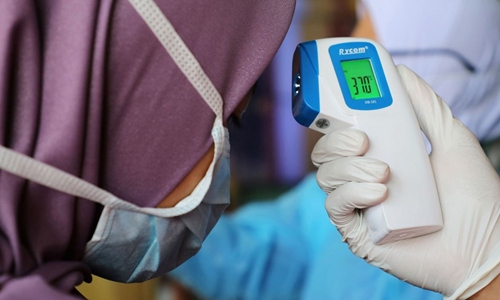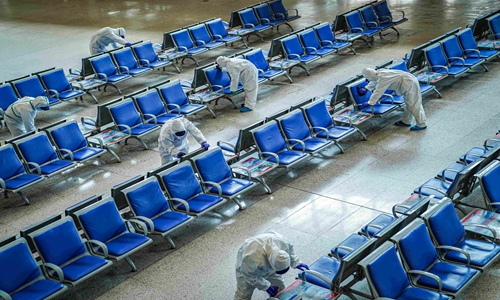HOME >> CHINA
Infectivity of asymptomatic patients nearly same as the confirmed: studies
By Liu Caiyu, Wan Lin and Zhang Han Source:Global Times Published: 2020/3/29 21:48:40

Rwanda Prime Minister's Office has urged the public to avoid contact with people suffering from flu-like symptoms, coughing or high fever. Photo: Xinhua
A woman in Central China's Henan Province was confirmed to be infected with COVID-19 on Saturday after coming into contact with an asymptomatic patient, sounding a further alarm for the public about the infectivity of asymptomatic cases when Chinese cities are embracing work resumption.
For a long time, those silent virus carriers - asymptomatic patients - have been controversial regarding their infectivity but the news of the woman in Luohe, Henan Province, who was confirmed after having close contact with an asymptomatic patient who contracted the virus from another asymptomatic patient, further triggered public concerns.
The woman, surnamed Wang, was confirmed positive after meeting with her friend surnamed Zhang in Pingdingshan on March 21, who reportedly had closely contact with another asymptomatic patient who had a travel history to Wuhan. Zhang only tested positive for COVID-19 during a physical check on March 26.
A recent study showed the infectivity of asymptomatic patients (having no clinical symptoms but testing positive for COVID-19) could be nearly the same as confirmed cases. Scientists with the Ningbo Center for Disease Control and Prevention in East China's Zhejiang Province recently found that 6.3 percent of confirmed cases' close contacts were ultimately infected with the virus. The percentage for asymptomatic patients' close contacts was 4.4 percent. Such a difference is of no statistical significance.
Zhong Nanshan, a top Chinese respiratory expert, told the public in an interview with CGTN on Sunday that the infectivity of asymptomatic infections could be fairly high, and one asymptomatic patient could infect up to 3.5 persons.
No official data on the overall number of asymptomatic patients has been reported by Chinese health authorities. They are not counted as "confirmed cases," according to the Chinese National Health Commission.
In general, the infection rate is very high for those who are in close contact with asymptomatic patients. However, the recent number of newly confirmed cases of COVID-19 infection has not increased, but declined, indicating that China does not have a large number of asymptomatic patients, Zhong said.

Government health employees and firefighters disinfect the Wuhan Railway Station with power sprayers on March 24. Photo: cnsphoto.com
Yang Zhanqiu, a Wuhan-based virologist, told the Global Times on Sunday that there may be an estimation of at least 200,000 virus varriers with no symptoms currently in China.
The asymptomatic patients have strong physical immunity or carry weak virus with less virulence, which is why they don't show symptoms but they still spread the virus in the early stage of infection, Yang explained.
However, he noted that these people contain limited amount of virus in their bodies and are not the main spreader of the virus. Asymptomatic infection cases, which can also become a source of infection, are mainly found among close contacts of confirmed cases. A few asymptomatic infections may develop into confirmed cases, but the vast majority will self-heal, experts had previously told the Global Times.
Asymptomatic patients show no symptoms as the majority of them could be in the incubation period. Some could remain asymptomatic for a longer time due to low virus doses in their bodies, but they can infect others. The latter case, however, should be very rare, said Li Liang, a tuberculosis expert with the Chinese CDC.
There could be silent virus carriers with extra-long incubation periods so that they did not show symptoms during quarantine, said Jiang Rongmeng, a member of the Chinese National Health Commission team studying the virus.
Despite having no official count, China requires asymptomatic patients to be quarantined for 14 days once they test positive for the virus. For the public, there is no need to panic or carry out universal nucleic acid tests. Social distancing and wearing masks would effectively protect people from silent carriers, experts noted.
As the overall epidemic situation in China improves, most Chinese cities are reporting zero new confirmed cases. Local governments should report COVID-19 in an accurate manner and they cannot hide about the data, citizens and experts urged, with many calling on the authority to release the actual number of asymptomatic patients.
Posted in: SOCIETY